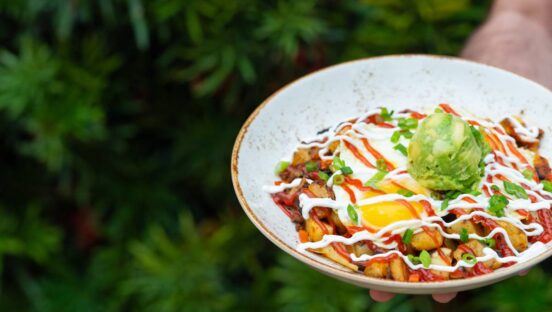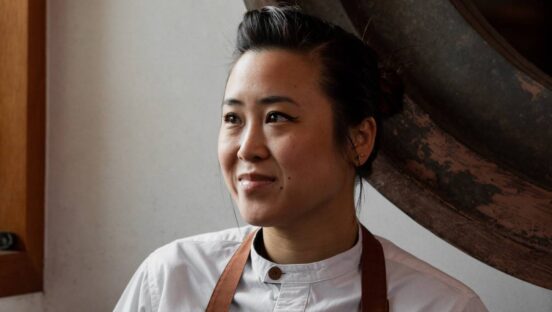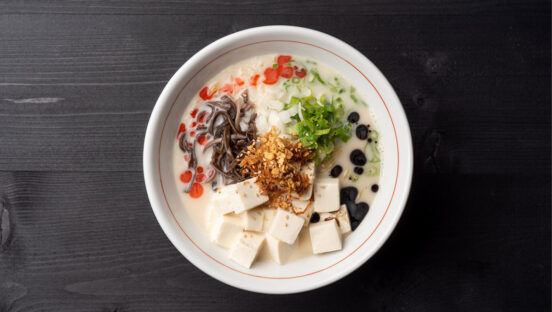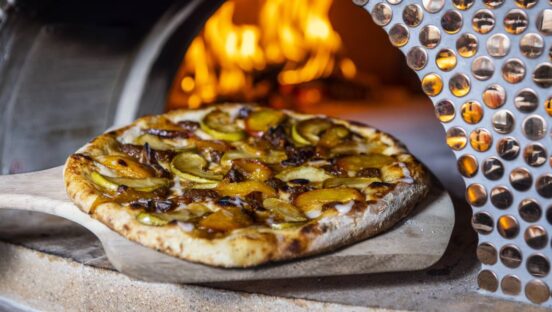

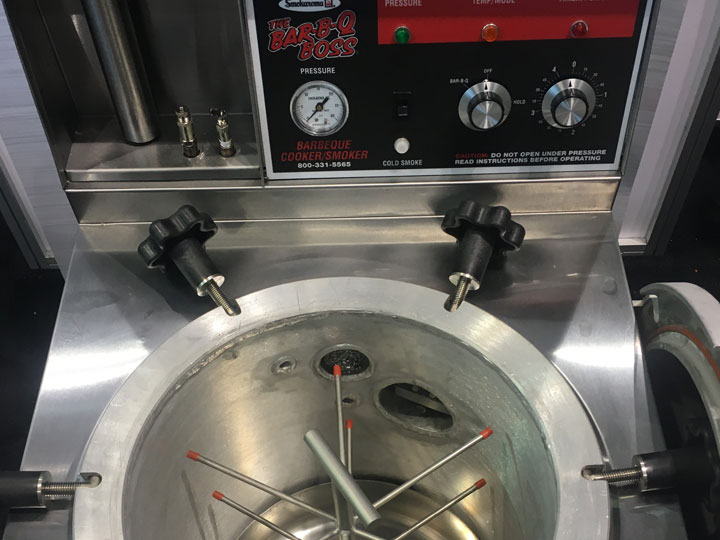









The 2017 National Restaurant Association Show at McCormick Place in Chicago brought together more than 67,000 attendees from all corners of the world and the restaurant industry. Everything from ingredients to technology to equipment to massage chairs to Chicago hot dogs were on display. Here is a recap of some of the standout products that could take your restaurant operation to the next level. Pictured is the Constellation dinnerware line from Libbey.
Studies show that six in 10 coffee consumers have tried cold brew coffee at least once or twice. But how many have experienced it soft-served in ice cream form? S&D exposed hordes of NRA Show attendees to the treat, which was one of the most buzzed-about items around (pun intended). I don’t drink coffee too often and I left the S&D booth vibrating. It was caffeine yes, but also an appreciation for the overall product, which launched in March. The TODDY cold brew coffee concentrates simplify the process for foodservice operations by alleviating the need to measure, steep, and filter coffee grounds to achieve that cold-brew formula, a process that can take an entire day for some. The concentrate is shelf stable and comes in Black Label (4:1 cold brew concentrate) and White Label (24:1). And yes, you can (and should) turn it into ice cream.
The countless people lined up for fried chicken might have missed this innovative machine. One of Broaster’s new revelations, the Smokaroma Pressure Smoker defies all smoking stereotypes. Want 40 pounds of ribs smoked in an hour? Don’t want to build a machine the size of a semi-truck? The compact machine occupies a small footprint and achieves the flavor chefs and consumers are looking for. Any flavor of wood chip can be added and the pressurized design actually locks in the juices, which can reduce product shrinkage by up to 40 percent. The product also remains moist and flavorful. You can even toss frozen meat in there. There’s also a Water Baffle option that can eliminate the need for a vent hood. In addition to the Smokaroma, Broaster had an Instant Burger machine on display. With it, two burgers can be cooked in less than a minute. Even better? There’s zero need for flipping (training cooks) and the direct energy transfer makes sure mistakes aren’t made. It also just requires a 120 volt, 30 amp dedicated electrical circuit. Imagine the possibilities.
Craft beer and wine glasses are all the rage. Does that mean guests should get the same vessel for a rare bourbon as they do a gin and tonic? Libbey doesn’t think so. In a partnership with the Kentucky Distillers’ Association and the famed Kentucky Bourbon Trail, Libbey designed a glass specifically for tasting bourbon and highlighting the best aspects of the spirit. The KDA has reported a 300 percent increase in attendance over the last decade for the Kentucky Bourbon Trail. If you’re one of those new guests, be sure to arrive equipped with the right tool. It’s built with a heavy sham, curved bowl, ideal-sized opening and fine rim. It’s also stackable to reduce storage space. Libbey had handfuls of new products on display in addition to the Bourbon glass, including the industry’s first dishwasher-designed beer flight tray (no more wood scrubbing, people), and a Constellation line of dinnerware that features Microban technology. The first-of-its kind porcelain product is 99.9 percent effective at inhibiting bacterial growth, including odor- and stain-causing microbes. Sure, every single person working at your restaurant washes their hands. But just in case, here’s an added level of protection that simply didn’t exist before.
If I’m being honest, I was a little bit underwhelmed with the technology section of the show. I felt like people were trying to sell me POS Systems like life insurance. However, I came away impressed with Rom Krupp and Marketing Vitals, a company with 97 restaurant brands in its client list, including Twin Peaks and Boston Pizza. Expect that number to balloon in the near future. The cloud-based restaurant intelligence company, which launched in 2014, is stacked with technological minds. So what does it do? It’s all about helping restaurants use data to predict results. The platform can show trending sales, the impact of holidays, events, weather, and more. It also tracks guest traffic to a tee, a flawed statistic in most operations to say the least. One feature that stood out was the Team Incentive Tools. This allows owners to track employee contests and see a projection on sales impact and receive daily updates on employees’ improvement. The mystery of upselling and how well front-of-the-house employees are actually doing is erased. Here are some questions Marketing Vitals can help answer: If I am looking at a price increase, how much is too much? Is my loyalty program generating loyalty, or just discounting the check? Which menu items can I safely remove without losing guests (Krupp pointed to this note as a major help for many brands he’s worked with, who really don’t have a firm grip on what’s actually selling and what’s ending up in the waste basket). Is the LTO driving incremental visits, or just cannibalizing the existing menu? This is just a small sample but it shows how Marketing Vitals is one of those companies actually concerned about the operator, not just the consumer waiting for their delivery on the other end.
I think we’re all learning (thank you, Taco Bell) that chicken has no limits. When you look at Tyson’s Boat Loaders, your eyes will register potato skin before you come to grips with this new reality. These boat-shaped carriers are made of 100 percent white meat chicken and come fully cooked, ready to heat. Notably, they can be filled what whatever the chef envisions, turning this menu item into one unique to the restaurant. That’s important in the appetizer-blurred world of today. For bar and grills especially, it’s helpful to not carry the same wings, fingers, and onion rings as everybody else. Some of Tyson’s recommendations: Waffles and syrup, cheesy mashed potatoes and bacon, and spinach artichoke dip. With snacking being what it is, it’s hard to go wrong with this kind of versatility and possibility.
As the fast food industry trends clean label, sending beverages in that direction is a natural progression. Panera famously started listing calories and sugars back in April in what was likely a sign of things to come. While there will always be a space for consumers to indulge on the classic soda options, Coca-Cola is making sure it crosses both boxes off the list. The FABI award-winning Barrilitos line is flavor-enhanced water with just 50—60 calories, no artificial flavors, flavored with real fruit juices, purées, and/or spices. I tried a few of these, including the Horchata, which you wouldn’t think could be made water-based like this. But it really works. The whole line does. Coca-Cola notes that there are 70 million potential consumers for aquas frescas in quick service alone. Coca-Cola had a lot going on in general at its booth. Just with the beloved Coca-Cola Freestyle machine, more than 20 new beverage brands are launching in June via software update using existing ingredients in the dispensers, meaning restaurant owners can forget worrying about new operation requirements. Barq’s Crème Soda is coming, as is Minute Maid Sparkling, and Mello Yello beverages. There will also be a new “Quick-Select” button to get to brands faster and a “Pour 3, Get $3” app promotion designed to drive up Freestyle traffic. Use the app to get three new beverage brands and Coca-Cola will send you a $3 Amazon gift card.
Wine on tap is pretty intriguing. There’s no denying that. There are some very obvious benefits: Sell higher-value wine to more consumers (not everybody wants to crack open a $500 bottle, but might pay $80 for a glass), simply sell more wine (again, not everybody wants to buy a bottle, even a cheap one), offer more variety, introduce guests to new options, offer smaller pours, better pairings, and so on and so on. Personally, I’m most interested in that final option. Why does a wine pairing for a tasting menu always have to present the same wines to every diner? I feel like it’s more of a logistical issue than a sommelier one. If you could truly offer quality wine on tap that caters to a consumer’s preferences, why wouldn’t you? It’s just not feasible when you’re talking about corking so many bottles for so few pours. Anyway, I spoke with Plum CEO David Koretz about this and much more. He bought an industrial-sized wine-on-tap system for his house and realized quickly that his wine was being oxidized. He explained to me why but I won’t embarrass myself trying to recount the details. The main point being that a machine ripping the cork out of a bottle, regardless of what comes next, does it no favors, especially when it comes to preserving wine. So, he invented Plum. The sleek machine’s double-cored needle pierces through the foil and closure, simultaneously extracting wine from the bottle and injecting argon gas to prevent oxidation. The result: one bottle can remain on tap for six months. Plum’s design allows for two bottles per device and includes an argon gas canister that preserves more than 200 bottles (refills are $29 or 2 cents per glass). There’s also a database built in of more than 7 million wines. The user can select the wine and the machine will bring it to its perfect temperature. The touch screen also allows for browsing of regions and an overall education on wine. The label displays on the front as you approach. To date, the machine has been a hit in hotels, Koretz says. In the future, he’s hoping to add restaurants to the portfolio.
In May, Upserve announced it grew 100 percent in the last year and is now managing more than $11 billion in annual transaction volume, making it the largest provider of cloud-based point of sale and analytics for the independent restaurant industry. We’re talking more than 32 million active diners and 23 million meals per month. Rosie Atkins, the vice president of product at Upserve, said that 90 percent of the company’s staff worked at restaurants. That’s why the product is so operator-driven. It’s all about making life easier for the restaurant. The partnership with Grubhub was front and center at the show. Upserve works on the restaurant end to make the third-party delivery service equation work. The online ordering service connects with the Breadcrumb POS system to allow operators to easily manage orders and menu items directly from the machine, as well as view financials and customer information. This prevents disruption and helps restaurants meet the boost in order volume. In fact, Atkins said they had to add a feature to accept the order because the original design was too fast. Menufy and Open Dining also joined Upserve’s online ordering program. BevSpot, MarketMan, PlateIQ, SimpleOrder, and xtraCHEF jumped into the inventory program. Harri is also on board with the workforce management program, and Opticard and Swipe It signed on for the expanding guest card program. Needless to say, Upserve is a company in motion. On a side note, when I stopped by, I left with a box of Sour Patch Kids. It was 1997 all over again, in all the best ways.
When I first read the news TGI Fridays joined OpenTable, I wasn’t sure what to think. My initial reaction was surprise, and then a little apprehension. Do casual dining guests use OpenTable? Would they? But as Scott Jampol, the SVP of marketing, explained, those sort of barriers are exactly the point. Why do we associate OpenTable with date night? Why do we think it only works at Per Se? The 18-year-old company has come a long way, and now serves some 22 million diners per month. Over time, Jampol said OpenTable has seen a demand for what it calls “everyday dining.” Guests search for it and look for it on the site. Reservations aren’t just for special occasions, Jampol said. Everybody wants to get a table on time, regardless of the occasion. OpenTable currently works with around 42,000 restaurants in nine countries. Jampol said the expansion of the company will be all-inclusive. Restaurants of every sort are welcome and all diners are in reach. In mid-May, OpenTable announced integration with QSR Automation’s DineTime platform. This allows QSR DineTime customers to tap into OpenTable’s global diner network by surfacing real-time reservation availability on OpenTable’s site and apps. The second phase of the integration is to see estimated wait times and for guests to have the ability to add their name to waitlists at participating restaurants before walking in the door. If that doesn’t sound like a perfect fit for casual dining, I don’t know what does. The goal for OpenTable, Jampol said, is to meet every demand of every diner. It appears that ideal is within sight.
It was hard to miss the Wisconsin Milk Marketing Board’s gigantic booth in North Hall. And for anybody who loves cheese (raises hand), it was a haven amid the madness. Wisconsin Cheese enjoyed a historic year, winning top honors at three major cheese competitions, including Best of Show at the American Cheese Society Competition, World Champion at the 2016 World Cheese Championship Cheese Contest, and Grand Champion at the U.S. Championship Cheese Contest. Here were some of the offerings: The Sartori Black Pepper Bellavitano is a hard cow’s milk cheese with a rich, creamy texture with notes of fruitiness and a sweet and tangy finish. This cheese, available in a variety of flavors including Merlot and Espresso, was named the Grand Champion of the 2017 U.S. Champion Cheese Contest. The Agropur Cheddar was made by Wisconsin Master Cheesemaker Terry Lensmire. His Lensmire’s Cheddar, aged one to two years, was runner-up at the same contest. The next placing cheese was the Marieke Gouda Belegen by Marieke Penterman. The cheese presents a mellow flavor with hints of toasted nuts and is yet another honor for Penterman, who has more than 90 national and international awards.
An operator came up to me at our booth and sarcastically asked, “How am I supposed to find an oven around here?” Yes, there was more kitchen equipment than most of our brains could handle. Deciding which device to bring into a restaurant is not a task I envy operators. Like anything, it comes down to budget, footprint, functionality, and exposure, among other things. There’s no denying, however, that this decision needs to be made with careful deliberation. It’s a serious investment. I took a tour of Vulcan’s booth, where the Kitchen Innovations Award-winning VC5G Gas Convection Oven was on display. The machine has fully removable doors and a top Energy Star efficiency score. Those doors are also dishwasher-safe, which reduces the need to open them to check for doneness. In one of those aha moments, the racks have cutouts so you can grab the food without burning yourself. Always important. There’s also digital time/temperature readouts and built-in diagnostics.



